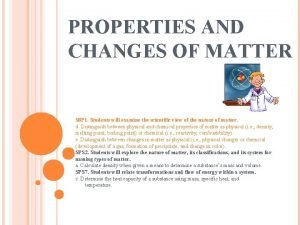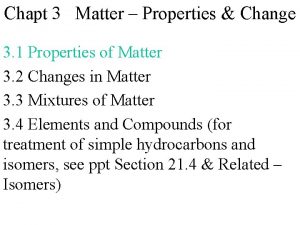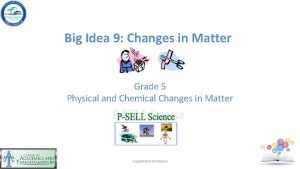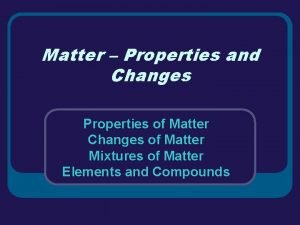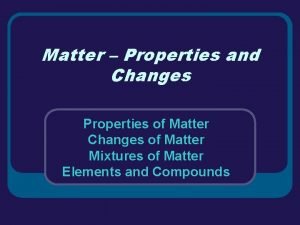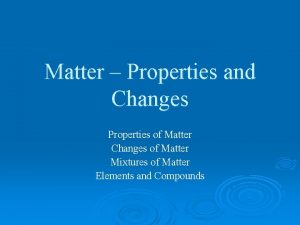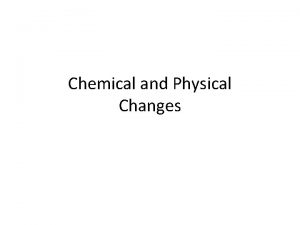Chemical Changes In Matter Chemical Properties Chemical Properties







- Slides: 7

Chemical Changes In Matter

Chemical Properties • Chemical Properties- are information about how matter reacts with other matter. Examples: • Reacts with Liquids • Reacts with Solids • Reacts easily • Does not react easily • Reacts with Oxygen

Chemical Changes or Chemical Reaction of Matter A chemical change is a change in which one kind of matter is changed into a different type of matter. New Matter is formed. - Burning - Rusting - Cooking - Film Processing - Digesting Food - Color Change - Odor Change - Can Not be reversed - Chemical Reaction

How do you know there was a Chemical Reaction or Change? • Clues: – Change in Color – A Smell or odor was given – Smoke or gas was released – Heat was given off

Law of Conservation of Matter • The same number of particles that exist before the reaction exist after the reaction. • Matter is never destroyed or created in chemical reactions. • The particles of one substance are rearranged to form a new substance.

Gases and Chemical Reactions. • When some substances are mixed together a reaction occurs. A new material forms and the change that has taken place is irreversible. How can this be proved? What You Will Need • • • A clear empty plastic bottle. A balloon Vinegar Baking soda (bicarbonate of soda) Goggles What To Do • Put a teaspoon of baking powder in the plastic bottle. • Add about 100 ml of vinegar. • Quickly stretch the balloon over the top of the bottle.

What Happens? • The baking soda reacts with the vinegar and fizzes. The balloon should inflate with the gas that is produced. The gas (carbon dioxide) is a new material created by the reaction. This is a chemical change, and unlike making a solution, which is a physical change, it is not at all easy to reverse. • You can experiment with other materials. • For the liquid you could try Coke or a citric acid solution. • For the solid, you could try icing sugar or Refreshers. • Alka Seltzers in water react very well. • Care should be taken when experimenting. Balloons can burst or leak, making a mess. All the materials mentioned above are perfectly safe with sensible precautions such as wearing goggles. Experimenting with other substances could produce more extreme reactions. Certainly, never experiment with household cleaning materials.
 Chemical change definition
Chemical change definition Properties and changes of matter worksheet
Properties and changes of matter worksheet Matter-properties and changes answer key
Matter-properties and changes answer key Changes in matter grade 5
Changes in matter grade 5 True or false: chemical and physical changes alter matter.
True or false: chemical and physical changes alter matter. Chemical properties and changes lesson 4
Chemical properties and changes lesson 4 Physical/chemical changes & properties color by number
Physical/chemical changes & properties color by number Section 1 chemical changes
Section 1 chemical changes

